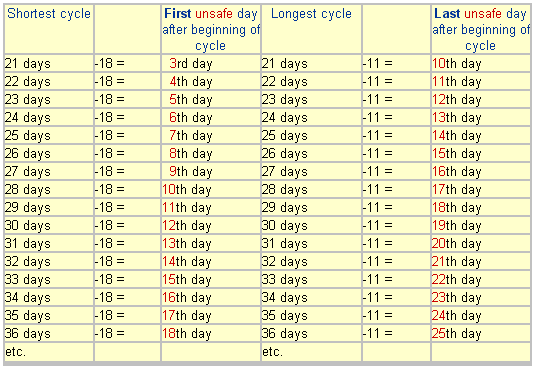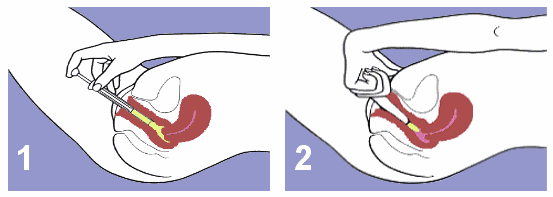|
4.4.1 METHODS OF CONTRACEPTION
Although the various contraceptive methods differ in effectiveness and sophistication, the principle of contraception itself is quite simple. As described in a previous section, the process of conception involves the fertilization of an egg by a sperm inside one of the Fallopian tubes leading to the eventual implantation of a growing cell cluster in the uterus, thus starting pregnancy. Obviously then, contraception, or the avoidance of pregnancy, involves an interference with this process by preventing either ovulation, fertilization, or implantation. This interference can take several different forms:
1. Preventing the release of an egg from the ovaries ("the pill").
2. Preventing the passage of the egg through the Fallopian tube (tubal ligation).
3. Preventing the sperm from becoming part of the ejaculated fluid (vasectomy).
4. Avoiding coitus at the time when an egg is available for fertilization (rhythm).
5. Preventing sperm from being deposited inside the vagina (withdrawal, condom).
6. Preventing the sperm inside the vagina from moving through and beyond the cervix (spermicides, diaphragm).
7. Hindering the process of implantation (IUD, "morning-after pill").
All contraceptive methods listed here have been developed through long and careful observation of the procreative process. They all involve the application of scientific knowledge or rational calculation, and most of them require the use of chemicals, special tools, gadgets, and devices or a calendar and a thermometer. In each case, human cunning prevents nature from simply taking its course. In short, contraception is always the result of a conscious decision which uses certain laws of nature to defy certain others.
This elementary fact has sometimes been obscured by writers who have tried to create a distinction between "natural" and "artificial" means of contraception. Such a distinction is arbitrary and unscientific. However, for the practical purposes of everyday life it is useful to distinguish between those contraceptive methods that require medical consultation and those that do not.
Surgery is needed in the case of sterilization (vasectomy, tubal ligation). A doctor's prescription is needed for contraceptive pills, "morning-after pills," diaphragms, and intra-uterine devices (IUDs). A doctor's advice and supervision are important for the rhythm method. There are three methods of contraception which can be used without any professional help: withdrawal, condom, and spermicides.
Some contraceptives require a doctor's prescription because they could be ineffective or dangerous if used indiscriminately. As a matter of fact, it makes sense to seek professional advice before choosing any method of contraception. Such advice is offered by all Planned Parenthood offices and other family planning clinics as well as by many private physicians. Not every method is suitable for everybody at all times. Making the right individual choice is the first step toward success. In some cases, religious reasons or personal habits rule out certain methods, and what works well with one person today may fail with another tomorrow. It is, therefore, essential to understand how each method works in order to ensure its proper application. Many unwanted pregnancies occur because of careless use of otherwise effective methods.
Some experts have said in the past that any method of contraception is better than none at all. However, some methods are so ineffective as to be practically useless. Among these is karezza, or coitus reservatus, a form of coitus in which the man tries to avoid ejaculation. Although such an attempt may have certain emotional and even spiritual values, it does not necessarily prevent pregnancies. Another questionable method consists of inserting a small sponge together with some spermicidal powder or liquid into the vagina. This is not only ineffective, but may also interfere with coitus and cause discomfort. Still another method is vaginal douching after coitus or, in other words, the washing out of the vagina with some sort of solution in the hope of removing the sperm. This procedure is useless because it can never come soon enough to make any difference. There are further certain "feminine hygiene" products which are advertised with hints at contraceptive powers. Nevertheless, they are quite ineffective in that respect and may actually be harmful to the vaginal tissue. In general, vaginal douching and spraying should be avoided because it is unnecessary. The vagina cleanses itself with its own secretions. Too much interference can only upset the vaginal ecology and cause infection or irritation. (See also "Venereal Diseases.") The following pages describe only those methods of contraception that work reasonably welI.
CONTRACEPTIVE METHODS FOR MEN
Withdrawal
The withdrawal method, also known by its Latin name coitus interruptus, is probably the oldest method of contraception. It simply means that during coitus the man withdraws his penis from the woman's vagina just before he ejaculates. As a result, his sperm is not deposited inside the woman's body and therefore cannot fertilize the egg.
While this sounds convincing in theory, it does not always work in practice. Many men have difficulty finding the right moment for withdrawal. The resulting worry and the need to control sexual reactions at all times can create considerable tension between sexual partners. It is also possible that some sperm is released from the penis well in advance of the actual ejaculation. Furthermore, even sperm cells that have been ejaculated outside the vagina can move inside by themselves as long as they are in contact with a moist surface. For these reasons, withdrawal is not reliable as a method of contraception. Its only advantage is the fact that it needs no preparation and can be used anytime. However, its disadvantages are so serious that most people will find it appropriate only in unusual circumstances, when no other methods are available.
Effectiveness: not very effective, but better than nothing.
CONDOMS
 |
The condom is an excellent contraceptive which also offers some protection against venereal disease. In the United States today various brands of condoms are available to everyone in drugstores or in public vending machines. Many of the newer condoms are prefabricated and some are sold in a variety of colors or with ornamented tips ("French ticklers").
Condom
The condom, also popularly known as prophylactic or rubber, is a sheath made of thin rubber, gut, or plastic. It is shaped like the finger of a glove and it is worn over the penis during sexual intercourse. Because it catches and retains the man's sperm after ejaculation, the woman cannot become pregnant.
The condom is a very effective contraceptive if used properly. It must be put on the erect penis before coitus (not just before ejaculation). At the tip of the penis, some space has to be left to accommodate the expected semen, otherwise the condom may burst. Immediately after ejaculation, the man must withdraw his penis before losing his erection, holding on to the condom at its base so that it cannot slip off. The effectiveness ran be increased still further by putting some spermicidal cream or jelly on the outside of the condom after it is in place on the penis, or by having the woman use spermicidal foam at the same time.
Despite its obvious advantages, some people object to the condom either because they do not like the procedure of putting it on during their love play or because they claim that the feeling of rubber dulls their sensation. Nevertheless, all things considered, the condom is still one of the simplest, safest, and therefore best contraceptives available. Moreover, it also provides some protection against venereal diseases. Condoms are not expensive and can be bought in drugstores without a prescription.
Effectiveness: about 95 percent, more if the woman uses foam.
CONTRACEPTIVE METHODS FOR WOMEN
Rhythm
The rhythm method of contraception consists simply of abstinence from coitus during a woman's fertile days. Although this method seems easy and effective in principle, it is quite complicated and unreliable in application.
The first problem is to determine the exact number of fertile or "unsafe" days that require coital abstinence. A woman can become pregnant only as long as an egg is in one of her Fallopian tubes. This means that her fertile or "unsafe" days are those shortly before, during, and shortly after ovulation. Abstinence before ovulation is necessary because sperm cells can stay alive inside a woman's body for some time, and abstinence afterwards is necessary because an egg can be fertilized for some time after ovulation. Since menstrual cycles are often irregular and the day of ovulation can therefore not be predicted accurately, one has to allow for a period of at least a week in which an egg could be available for fertilization. To this must be added the possible survival time of sperm cells (up to five days inside the Fallopian tubes), plus another day or two as a margin of safety. Therefore, on the average, the fertile or "unsafe" days add up to about two weeks of each menstrual cycle.
The next question is: When exactly do these two weeks begin? As mentioned above, everything depends on the moment of ovulation. (If it were possible to calculate this moment accurately, the "unsafe" days would be much less than two weeks.) An ovulation usually occurs in the middle of the menstrual cycle or, to be more precise, about two weeks before the beginning of the next cycle. Unfortunately, it is very difficult to predict the beginning of the next cycle. Many women, especially when they are young, or when they are approaching menopause, have irregular cycles, and even for women with regular cycles a variation of two to five days is quite normal. (See also "The Female Sex Organs.")
THE RHYTHM METHOD (CALENDAR)
HOW TO DETERMINE THE "UNSAFE" DAYS
THE RHYTHM METHOD (BASAL TEMPERATURE)
BASAL BODY TEMPERATURE DURING THE MENSTRUAL CYCLE
 |
In order to gain at least some certainty, a woman can use two different strategies (and many women who practice the "rhythm method" actually use both at the same time): First, she can take her body temperature with a special thermometer every morning before getting out of bed (basal temperature). Before each ovulation, there is a slight drop in body temperature followed by a slight rise for the rest of the menstrual cyde. By comparing her temperature records of at least six previous months, the woman can calculate the lime of her next ovulation. A second way of finding the "unsafe" days consists of keeping a calendar record of menstrual cycles for at least eight months. Using this calendar record, a woman selects her longest and her shortest cycle. She then subtracts 18 days from her shortest cycle to find the first "unsafe" day of her present cycle. She further subtracts 11 days from her longest cycle to find the last "unsafe" day of her present cycle. For example, if the shortest cycle is 25 days, then 25 - 18 = 7 (the seventh day is the first "unsafe" day ot her present cycle): If the longest cycle is 31 days, then 31 - 11= 20 (the twentieth day is the last "unsafe" day of her present cycle).
Each of these two versions of the rhythm method (basal temperature or calendar) requires expert professional guidance. No woman should try them on her own. However, even in combination and with the help of a doctor they are not very reliable. The rhythm method does not work at all for women whose longest cycle differs more than 10 days from the shortest. Physical and emotional problems can change the length of cycles, and there is also the possibility that some women may ovulate in response to coitus itself. Apart from its lack of reliability, the method also has the disadvantage of subjecting coitus to the rule of calendar and thermometer. Nevertheless, many people use the rhythm method for religious reasons, since at present it is the only method of contraception approved by the Catholic church.
Recently, another version of the rhythm method has gained some currency. Known as the "mucus method" or "Billings method" (after its original proponents), it is based on the observation that the normally cloudy cervical mucus becomes clear and slippery during ovulation. Careful self-observation with the help of speculum and hand mirror can therefore tell a woman when ovulation has occurred. This kind of information can, over time, be used to predict the fertile, "unsafe"' days on which coitus is to be avoided. This method cannot really be helpful without professional supervision. Even so, it remains of limited value and is therefore often combined with the "basal temperature method." All three versions of the rhythm method have their drawbacks, however, no matter how they are used in combination.
Effectiveness: not very effective.
Spermicides
Spermicides are chemical substances that kill sperm cells and thus prevent any possible fertilizations. Spermicidal preparations are available in drug stores without prescription as vaginal foams, creams, jellies, foaming tablets, or suppositories. Some brands of spermicides may cause allergic reactions in some women. In these cases, a doctor should he consulted. Should a spermicidal preparation fail and pregnancy occur, the baby will in no way be affected.
Vaginal Foam
Vaginal foam comes in a small aerosol can with a special applicator. (The best known brand names are Emko, Conceptrol, and Delfen). After shaking the can, the woman fills the applicator with foam and then, lying down, inserts it deep into her vagina. This must be done not more than half an hour before each coitus. Two applications are better than one. The foam kills the sperm and also blocks the cervix mechanically, thus preventing any sperm cells that might have survived from entering the uterus. The protection can be increased further if the man uses a condom at the same time.
Effectiveness: about 90 percent; if the man also wears a condom, close to 100 percent.
Spermicidal Creams and Jellies
Spermicidal creams or jellies are less effective than foam because they sometimes disperse unevenly. Some can be used by themselves, just as vaginal foam. However, they provide much greater protection when used together with a diaphragm. If no diaphragm is available, the man should wear a condom.
Effectiveness: not very effective without a diaphragm.
Vaginal Foaming Tablets and Suppositories
Vaginal foaming tablets and suppositories can only work when they have time enough to dissolve inside the vagina. They must, therefore, be inserted 10 to 15 minutes before each coitus. However, if used alone they do not offer much protection against pregnancy.
Effectiveness: not very effective. I
Diaphragm and Jelly
The diaphragm is a small, flexible, bowl-shaped device made of rubber that fits closely over the cervix, where it mechanically blocks the sperm cells from entering the uterus. In order to increase its effectiveness, the diaphragm is used together with a spermicidal jelly or cream, which is put inside it and spread around its rim. Since different women are built differently, diaphragms come in different sizes and have to be fitted by a doctor. (A woman should be rechecked for size every two years and after each pregnancy.) The doctor will also teach the woman how to insert the diaphragm properly.
The diaphragm is inserted up to six hours before sexual intercourse and must be left in place for at least eight hours afterwards, if the couple wants to engage in coitus again before that time, more cream or jelly must be inserted into the vagina (without removing the diaphragm, of course). After the diaphragm has been removed, it is washed with soap and water and can be used again.
Effectiveness: very effective when used with spermicidal jelly or cream.
APPLICATION OF SPERMICIDES
Using spermicides. 1. Inserting spermicidal foam with an applicator.
2. Inserting a spermicidal suppository.
APPLICATION OF SPERMICIDAL JELLY AND INSERTION OF DIAPHRAGM
Inserting the diaphragm. 1. Putting spermicidal jelly inside the diaphragm and on its rim.
2. Squeezing the diaphragm together for insertion.
3. Putting the diaphragm on the cervix and checking its correct position.
FIVE MODERN INTRA-UTERINE DEVICES (lUD's)
INSERTION OF IUD (LIPPES LOOP)
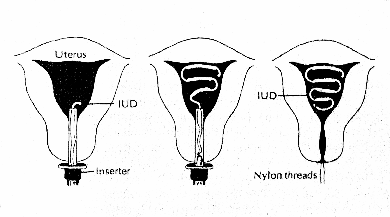 |
Intra-uterine Devices (lUDs)
Intra-uterine (contraceptive) devices, or lUDs for short, have been known since ancient times. However, in recent years new types of these devices have been developed. A modern intra-uterine device is a small piece of flexible metal or plastic with nylon threads attached to the bottom. As the name indicates, it is inserted by a doctor into a woman's uterus where it prevents pregnancy. Intra-uterine devices come in various shapes and sizes (the "loop", the "seven", the "coil," and so on).
At present, there is still no satisfactory explanation of how the IUD works. Perhaps it somehow keeps the sperm cells and the egg from meeting under the right conditions, or it prevents the fertilized egg from being implanted in the uterine wall. Several other theories have been suggested. Only one thing is certain: The IUD is very effective as a contraceptive device as long as it is in place. It can be worn for years without interruption and, of course, it can be removed at any time if the woman wants to become pregnant. Recently a new type of IUD has been developed which contains hormones similar to those used in the "pill". The device, known as "Progestasert", thus actually combines the features of two contraceptive methods. However, unlike other lUDs, it must be replaced about once a year.
Unfortunately, in some cases the IUD slips out without the woman's know!edge. It is important, therefore, to check its presence after each menstrual period by feeling for the nylon strings which reach a little way into the vagina. In certain other cases, particularly if the woman has not yet had any children, the IUD may cause severe cramps and bleeding. This may force the doctor to remove it. Many women, however, adapt easily to the IUD after some initial discomfort.
Effectiveness: very effective.
"The Pill"
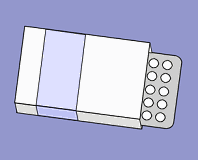 |
Contraceptive pills are made of synthetic hormones (estrogen and progestagens) which are similar to those produced by a woman's ovaries. Contraceptive pills prevent any egg from being released from the ovaries. The pills may also have other properties, such as changing the quality of the cervical mucus. This, in turn, may make it more difficult for the sperm to enter the uterus. As a result, the woman cannot become pregnant.
The pills come in packages made to last one month. One pill is taken every day for 20 or 21 days beginning with the fifth day of the menstrual cycle. When the package is empty, the woman stops taking any more pills until the fifth day of her new menstrual cycle. (Some packages contain 28 pills, the last seven without medication.)
The pills can work only if taken regularly. It is advisable, therefore, to take the pill every day at the same time (e.g., when waking up, brushing one's teeth in the morning, at breakfast, at supper, or going to bed). Such a daily routine will prevent a woman from forgetting a pill. If she does forget one pill, she can take two pills the next day at the regular time and continue as usual. However, if she forgot two pills in a row, she should also use another contraceptive method for the rest of the cycle.
Contraceptive pills are available only on prescription, since there are some women who should not take them. Recently several negative side effects have been reported, especially for women over forty, A medical examination will determine whether the pills are appropriate in any individual case.
Some women who take contraceptive pills at first experience some symptoms similar to those of pregnancy: a weight gain, slight nausea, and a tenderness and an enlargement of the breasts. These side effects usually disappear within a few months. However, if they persist, a switch to another brand of pills may be indicated. Occasionally one can read reports that the use of contraceptive pills carries the risk of blood clotting. However, this
relative risk is much greater with pregnancy.
Effectiveness: almost 100 percent.
The "Morning-after Pill"
A woman who has engaged in coitus without using any contraceptive method, or who knows that the method she used has failed and who has reason to believe that she might become pregnant, can still prevent this from happening by taking a so-called morning-after pill. This pill (a high dosage of estrogen) will prevent any fertilized egg from being implanted in the uterine wall. It must be taken within three to five days after coitus and is available only by prescription. A doctor has to evaluate several health factors before prescribing it. Even where there are no medical objections, the pill may cause very unpleasant temporary side effects, such as nausea and vomiting. In some cases, serious long-term aftereffects have been reported. However, many women would rather endure those than the worry about an unwanted pregnancy. Still, it is obvious that the morning-after pill cannot be used as a regular means of contraception.
Effectiveness: almost 100 percent.
A CONTRACEPTIVE METHOD FOR EITHER MEN OR WOMEN
Sterilization
Men and women who have definitely decided that they do not want any (or any more) children may choose the safest contraceptive method of all, sterilization, i.e., an operation that makes them infertile. The result of this operation should be considered final. Doctors are working on new surgical techniques that would allow for a reversal and thus restore fertiliy, but at present the chances are still slim at best.
VASECTOMY AND TUBAL LIGATION
A. Vasectomy: A portion of each vas deferens is removed and the cut ends are tied.
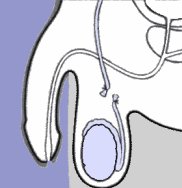 |
B. Tubal Ligation: A portion of each Fallopian tube is tied and cut out. In a few weeks, the cut ends of the tubes are scarred shut and separated from each other (insert).
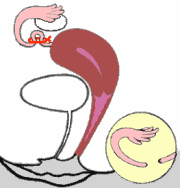 |
For Men: Vasectomy
The sterilization of a man, called vasectomy, is a relatively simple and safe operation which does not take more than a few minutes in the doctor's office. It involves the cutting and tying of the thin tubes on both sides of the scrotum through which the sperm travels. As a result of the operation, the sperm cells can no longer become part of the ejaculated fluid but are absorbed by the body. This means that the man is now unable to make a woman pregnant. In every other respect, there is no change; erection, orgasm, and ejaculation occur just as before. In other words, a vasectomy does not affect a man's sexual desire or performance, although some sterilized men enjoy sexual intercourse more because they no longer have to worry about causing an unwanted pregnancy.
Effectiveness: virtually 100 percent.
For Women: Tubal Ligation
The sterilization of a woman, called tubal ligation, consists of cutting and tying or cauterizing the Fallopian tubes through which her eggs travel to the uterus. Since these tubes are inside the woman's body, the operation is more complicated than for a man. Often hospitalization, at least for a day, is necessary. However, some doctors now use a new surgical technique (laparoscopy) which simplifies and shortens the operation. As a result of a tubal ligation, egg and sperm cells can no longer meet, and thus the woman can no longer become pregnant. In every other respect there is no change; her feelings and her capacity for orgasm are the same as before. In other words, a tubal ligation does not affect a woman's sexual desire or performance, except perhaps in a positive way since she no longer has to worry about an unwanted pregnancy.
Effectiveness: virtually 100 percent.
FUTURE METHODS OF CONTRACEPTION
Medical research has been trying for years to find a contraceptive pill for men. These efforts are beginning to produce some practical results, although at the moment longer-range testing is still necessary. In the meantime, several new contraceptive methods for women are being studied. Among these is a pill that would not have to be taken every day but only before sexual intercourse. Another method consists of the implantation of a small contraceptive capsule under the skin where it could possibly keep releasing its active substances into the bloodstream for years. Still another method involves prostaglandins (substances that can cause uterine contractions) which would prevent pregnancy in spite of fertilization (or could terminate a pregnancy at any time). There is further the possibility of a hormone injection every three or six months which could replace the daily pill known today.
As is obvious from this brief summary, most experimental contraceptive methods still leave the initiative and responsibility for their use mainly to women. It is to be hoped that future research will put renewed emphasis on contraceptives for men. What we really need is a range of contraceptive methods that fulfills the demand for complete sexual equality.
|


